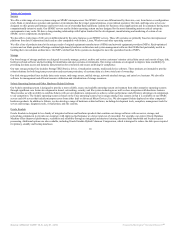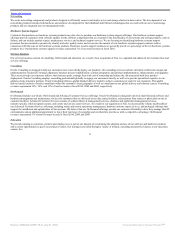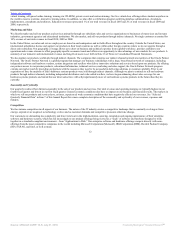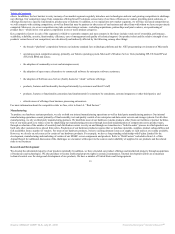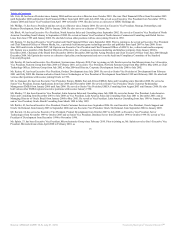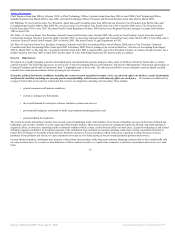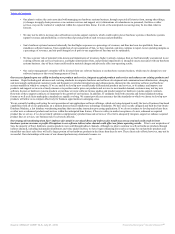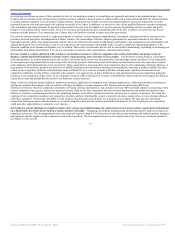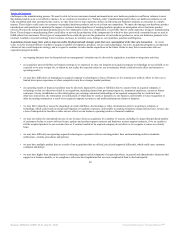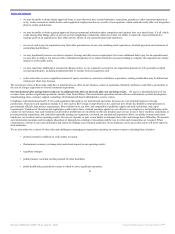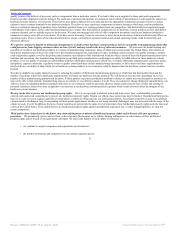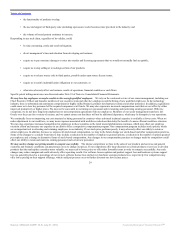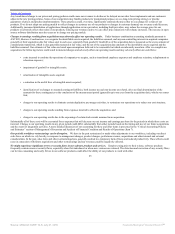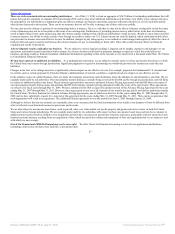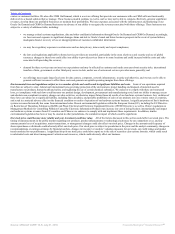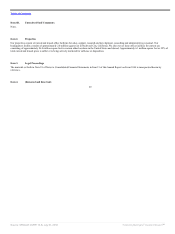Oracle 2009 Annual Report Download - page 24
Download and view the complete annual report
Please find page 24 of the 2009 Oracle annual report below. You can navigate through the pages in the report by either clicking on the pages listed below, or by using the keyword search tool below to find specific information within the annual report.
Table of Contents
challenges in the manufacturing process. We must be able to forecast customer demand and manufacture new hardware products in sufficient volumes to meet
this demand and do so in a cost effective manner. As we continue to transition to a “build-to-order” manufacturing model where our hardware products are not
fully assembled until after customers place orders, we may from time to time experience delays in delivering our hardware products to customers in a timely
manner. These delays could cause our customers to purchase hardware products and services from our competitors. We must also manage new hardware product
introductions and transitions to minimize the impact of customer delayed purchases of existing hardware products in anticipation of new hardware product
releases. Because the design and manufacturing process for components is also very complicated, it is possible that we could experience design or manufacturing
flaws. These design or manufacturing flaws could delay or prevent the production of the components for which we have previously committed to pay or need to
fulfill orders from customers. These types of component flaws could also prevent the production of our hardware products or cause our hardware products to be
returned, recalled or rejected resulting in lost revenues, increases in warranty costs, damage to our reputation, penalties and litigation.
Acquisitions present many risks, and we may not realize the financial and strategic goals that were contemplated at the time of a transaction. In recent
years, we have invested billions of dollars to acquire a number of companies, products, services and technologies. An active acquisition program is an important
element of our overall corporate strategy, and we expect to continue to make similar acquisitions in the future. Risks we may face in connection with our
acquisition program include:
• our ongoing business may be disrupted and our management’s attention may be diverted by acquisition, transition or integration activities;
• an acquisition may not further our business strategy as we expected, we may not integrate an acquired company or technology as successfully as we
expected or we may overpay for, or otherwise not realize the expected return on, our investments, which could adversely affect our business or
operating results;
• we may have difficulties (i) managing an acquired company’s technologies or lines of business or (ii) entering new markets where we have no or
limited direct prior experience or where competitors may have stronger market positions;
• our operating results or financial condition may be adversely impacted by claims or liabilities that we assume from an acquired company or
technology or that are otherwise related to an acquisition, including claims from government agencies, terminated employees, current or former
customers, former stockholders or other third parties; pre-existing contractual relationships of an acquired company that we would not have
otherwise entered into, the termination or modification of which may be costly or disruptive to our business; unfavorable revenue recognition or
other accounting treatment as a result of an acquired company’s practices; and intellectual property claims or disputes;
• we may fail to identify or assess the magnitude of certain liabilities, shortcomings or other circumstances prior to acquiring a company or
technology, which could result in unexpected litigation or regulatory exposure, unfavorable accounting treatment, unexpected increases in taxes due,
a loss of anticipated tax benefits or other adverse effects on our business, operating results or financial condition;
• we may not realize the anticipated increase in our revenues from an acquisition for a number of reasons, including if a larger than predicted number
of customers decline to renew software license updates and product support contracts and hardware systems support contracts, if we are unable to
sell the acquired products to our customer base or if contract models of an acquired company do not allow us to recognize revenues on a timely
basis;
• we may have difficulty incorporating acquired technologies or products with our existing product lines and maintaining uniform standards,
architecture, controls, procedures and policies;
• we may have multiple product lines as a result of our acquisitions that are offered, priced and supported differently, which could cause customer
confusion and delays;
• we may have higher than anticipated costs in continuing support and development of acquired products, in general and administrative functions that
support new business models, or in compliance with associated regulations that are more complicated than we had anticipated;
20
Source: ORACLE CORP, 10-K, July 01, 2010 Powered by Morningstar® Document Research℠


